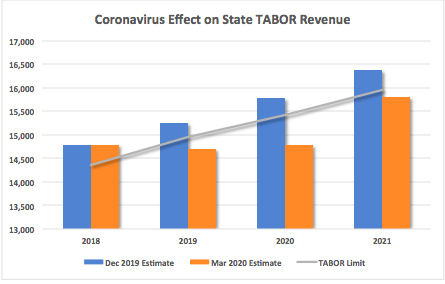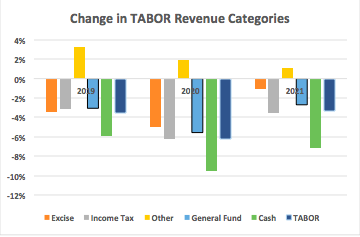Amid forced shutdowns, lock-downs, and stay-at-homes, as businesses and individuals struggle to avoid bankruptcy, the ripples are beginning to reach state government finances. According to Legislative Council’s quarterly economic forecast, Taxpayer’s Bill of Rights (TABOR) revenues, which had been projected to grow robustly in excess of the Referendum C limits, are now expected to be flat through next fiscal year.
The cumulative loss over the next three years to TABOR-limited revenue – taxes and fees – is estimated to be over $2.1 billion, with nearly a billion of that coming in the FY20-21 year. And instead of figuring out how to refund – or avoid refunding – nearly $1.1 billion over that time period, the state will instead fall short of the TABOR limit each year.
The next chart shows the percentage change in the various TABOR revenue categories from the December estimate to the March estimate. Excise Taxes, Income Taxes, and Other Taxes go to the General Fund. Cash Funds are funded predominantly by fees. From the chart, it is evident that the fees are more volatile than the taxes. (The Other category, much smaller than the others, is somewhat larger as a result of increased insurance income.)
The bad news for taxpayers is that you won’t be receiving a TABOR refund any time in the next few years.
The good news is that, since Gov. Polis and the legislative Democrats were feverishly working on a way of keeping the refund money, either through tax changes or increased targeted credits, they’ll be having to live within their means as well.
Joshua Sharf is a senior fellow in fiscal policy at the Independence Institute, a free market think tank in Denver.




